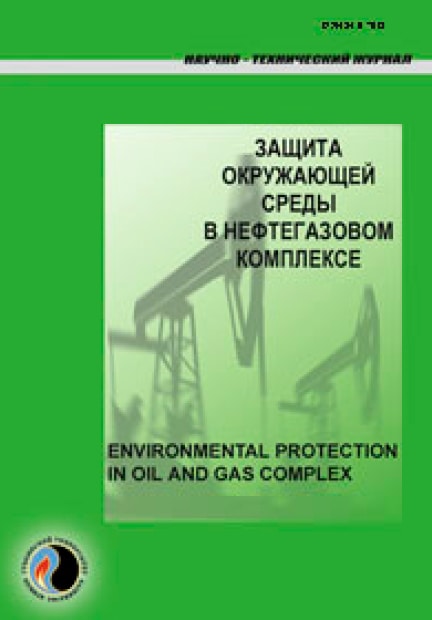Scientific and technical journal
«Environmental protection in oil and gas complex»
ISSN 2411-7013

Carbon footprint reduction technologies. Laboratory evaluation of the efficiency of solid adsorbents for flue gas treatment
UDC: 541.183
DOI: -
Authors:
1 Peter the Great Saint-Petersburg Polytechnic University, Saint Petersburg, Russia
2 Gazpromneft NTC, Saint Petersburg, Russia
3 Neo Engineering, Saint Petersburg, Russia
Keywords: adsorption, zeolites, sorbents, capture, flue gases, carbon dioxide, decarbonisation, carbon footprint, MOF
Annotation:
The article provides an analysis of carbon dioxide capture technologies, considering their capabilities and applicability limitations. The main types of sorbents, such as zeolites, carbon-based sorbents, and metal-organic frameworks, are discussed, along with an assessment of their advantages and disadvantages. The impact of operating conditions on sorption efficiency is highlighted. The study presents an evaluation of the absorbent's CO2 adsorption capacity and selectivity, as well as an assessment of their moisture absorption. It was found that CaA zeolite is the most promising sorbent for CO2 capture at concentrations up to 1,5 %. Activated carbons and shungites exhibit low sorption activity under experimental conditions, with recommended usage conditions being high partial pressures and low temperatures. The presence of water vapor negatively affects the sorbents' capacity, necessitating consideration of their moisture absorption capacity. The research findings help identify the most promising and effective carbon dioxide capture technologies for various conditions and environments.
Bibliography:
1. State and Trends of Carbon Pricing / World Bank. – 2022. – URL: https://hdl.handle.net/10986/37455 (data obrashcheniya 11.12.2023).2. Sheveleva N.A. Napravleniya i metody dekarbonizatsii neftegazovogo sektora // Zashchita okruzhayushchey sredy v neftegazovom komplekse. – 2023. – № 2(311). – S. 25–31. – DOI: 10.33285/2411-7013-2023-2(311)-25-31
3. Amine-based solvent for CO2 absorption and its impact on carbon steel corrosion: A perspective review / Zhe Lun Ooi, Pui Yee Tan, Lian See Tan, Swee Pin Yeap // Chinese J. of Chemical Engineering. – 2020. – Vol. 28, Issue 5. – P. 1357–1367. – DOI: 10.1016/j.cjche.2020.02.029
4. Energetika i okhrana okruzhayushchey sredy: monogr. / V.I. Babiy, A.F. Belokonova, R.A. Belyy, L.D. Berman; pod red. N.G. Zalogina, L.I. Kroppa, Yu.M. Kostrikina. – M.: Energiya, 1979. – 351 s.
5. Roslyakov P.V., Egorova L.E., Ionkin I.L. Metody rascheta vybrosov vrednykh veshchestv s dymovymi gazami kotlov: ucheb. posobie. – M.: MEI, 2000. – 68 s.
6. Carbon hollow fiber membranes for a molecular sieve with precise-cutoff ultramicropores for superior hydrogen separation / Linfeng Lei, Fengjiao Pan, A. Lindbråthen [et al.] // Nature Communications. – 2021. – Vol. 12. – Article No. 268. – DOI: 10.1038/s41467-020-20628-9
7. Recent advances on mixed matrix membranes for CO2 separation / Ming Wang, Zhi Wang, Song Zhao [et al.] // Chinese J. of Chemical Engineering. – 2017. – Vol. 25, Issue 11. – P. 1581–1597. – DOI: 10.1016/j.cjche.2017.07.006
8. Current status and development of membranes for CO2/CH4 separation: A review / Yuan Zhang, J. Sunarso, Shaomin Liu, Rong Wang // Int. J. of Greenhouse Gas Control. – 2013. – Vol. 12. – P. 84–107. – DOI: 10.1016/j.ijggc.2012.10.009
9. Pellegrini L.A., De Guido G., Valentina V. Energy and exergy analysis of acid gas removal processes in the LNG production chain // J. of Natural Gas Science and Engineering. – 2019. – Vol. 61. – P. 303–319. – DOI: 10.1016/j.jngse.2018.11.016
10. Algal biofuel production coupled bioremediation of biomass power plant wastes based on Chlorella sp. C2 cultivation / Hui Chen, Jie Wang, Yanli Zheng [et al.] // Applied Energy. – 2018. – Vol. 211. – P. 296–305. – DOI: 10.1016/j.apenergy.2017.11.058
11. Performance evaluation of a green process for microalgal CO2 sequestration in closed photobioreactor using flue gas generated in-situ / G. Yadav, A. Karemore, S.K. Dash, R. Sen // Bioresource Technology. – 2015. – Vol. 191. – P. 399–406. – DOI: 10.1016/j.biortech.2015.04.040
12. Kinetic model for effects of simulated flue gas onto growth profiles of Chlorella sp. AE10 and Chlorella sp. Cv / Dujia Cheng, Xuyang Li, Yizhong Yuan, Quanyu Zhao // Biotechnology and Applied Biochemistry. – 2020. – Vol. 67, Issue 5. – P. 783–789. – DOI: 10.1002/bab.1829
13. Utilizatsiya uglekislogo gaza s uchetom klimaticheskikh osobennostey regiona / O.R. Latypov, A.B. Laptev, F.B. Shevlyakov [i dr.] // Problemy sbora, podgot. i transp. nefti i nefteproduktov. – 2023. – № 2(142). – S. 174–194. – DOI: 10.17122/ntj-oil-2023-2-174-194
14. Tekhnologiya dekarbonizatsii topochnykh gazov neftepererabatyvayushchikh predpriyatiy / O.R. Latypov, A.B. Laptev, F.B. Shevlyakov [i dr.] // Elektron. nauch. zhurn. Neftegazovoe delo. – 2022. – № 6. – S. 231–263. – DOI: 10.17122/ogbus-2022-6-231-263
15. Favre E. Carbon dioxide recovery from post-combustion processes: Can gas permeation membranes compete with absorption? // J. of Membrane Science. – 2007. – Vol. 294, Issue 1-2. – P. 50–59. – DOI: 10.1016/j.memsci.2007.02.007
16. Rakhmukov B.Kh. Adsorbtsiya na mikroporistom adsorbente vdol' linii ravnovesiya zhidkost' – par (tseolit NaX – voda) / B.Kh. Rakhmukov, I.I. Seliverstova, V.V. Serpinskiy, A.A. Fomkin // Izv. AN SSSR. Ser. khim. – 1979. – T. 28, № 11. – S. 2419–2422.
17. Hölderich W.F., van Bekkum H. Zeolites and related materials in organic syntheses. Brönsted and Lewis Catalysis // Studies in Surface Science and Catalysis. – 2001. – Vol. 137, Chapter 18. – P. 821–910. – DOI: 10.1016/S0167-2991(01)80260-3
18. Kel'tsev N.V. Osnovy adsorbtsionnoy tekhniki. – 2-e izd., pererab. i dop. – M.: Khimiya, 1984. – 592 s.